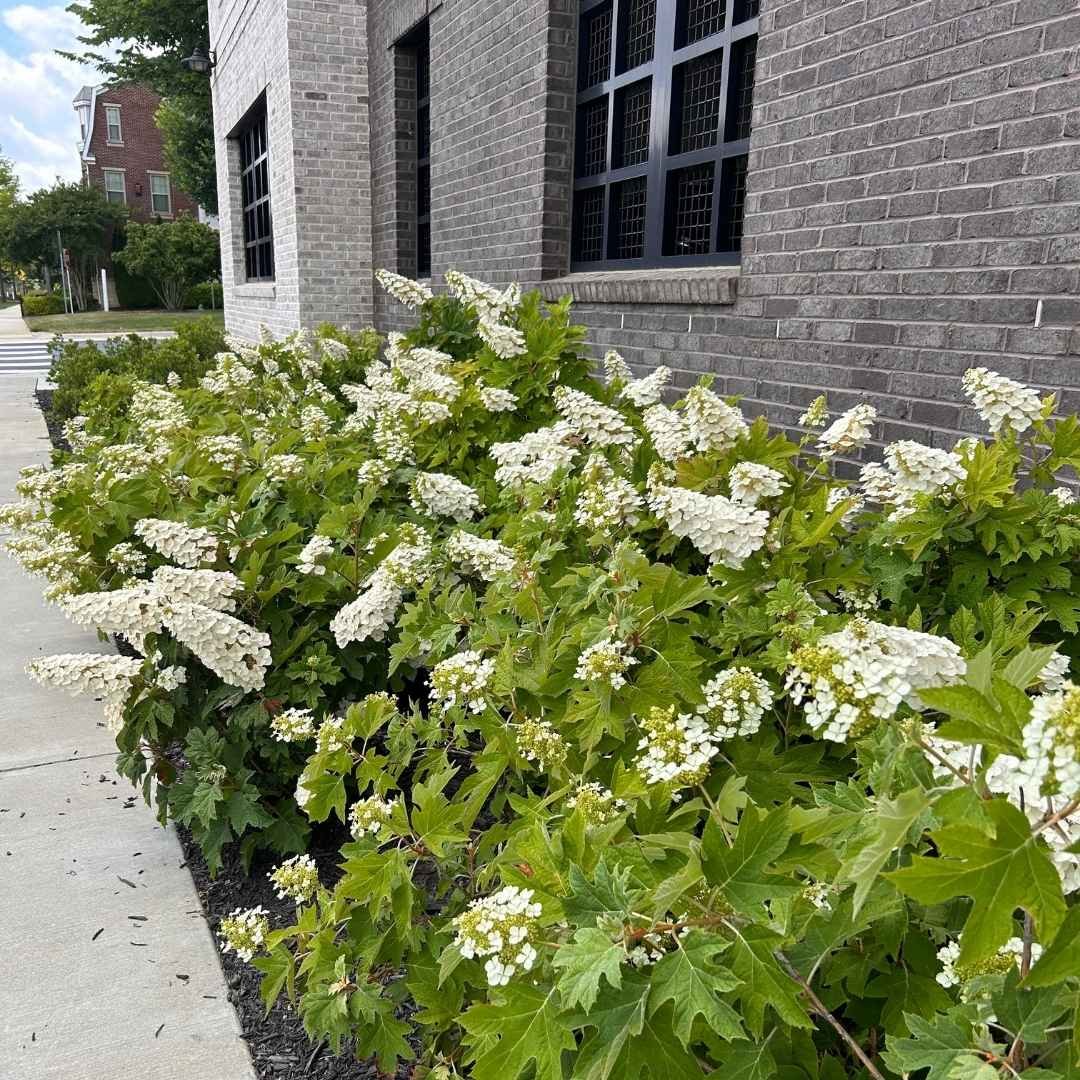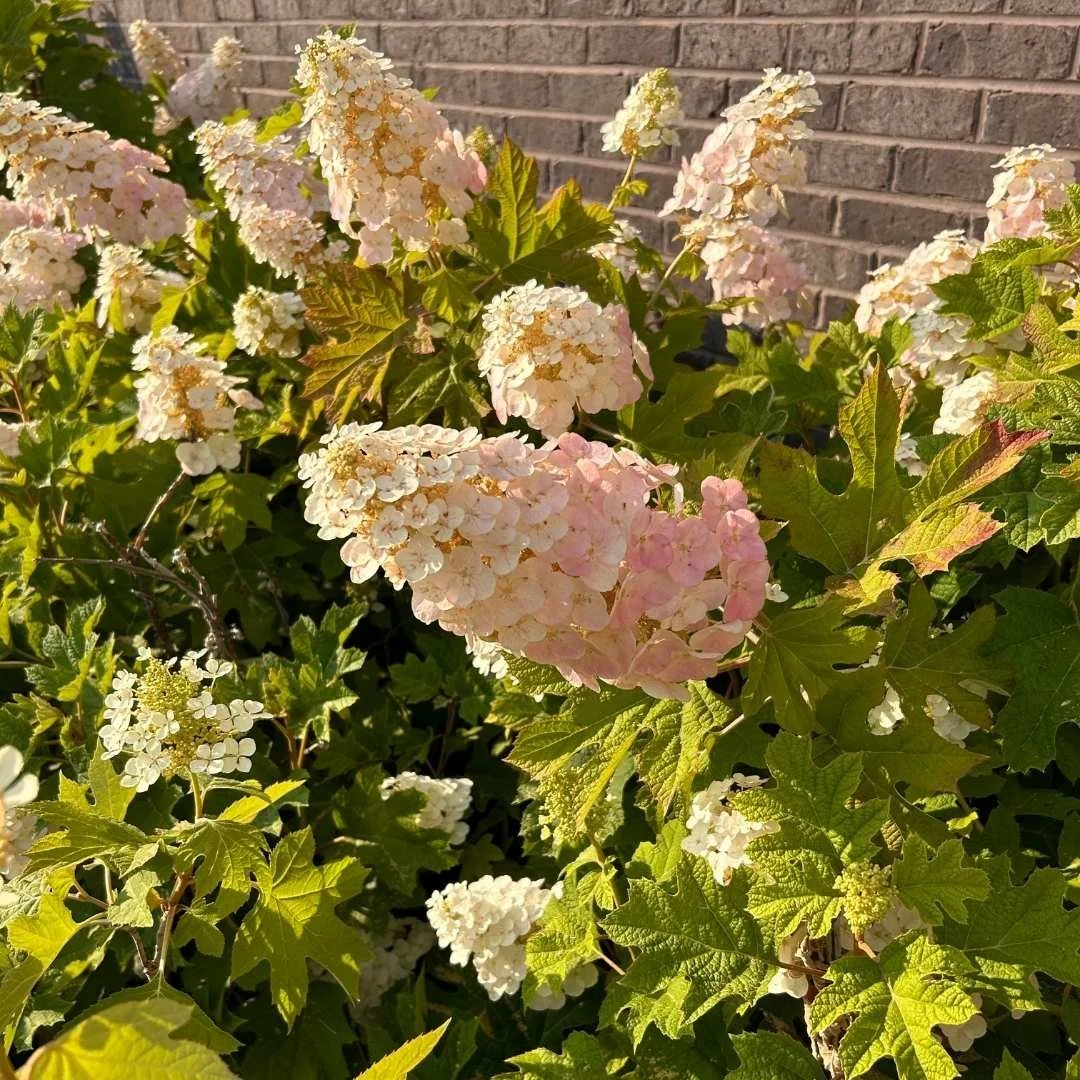The Vibrant Ruby Slippers Oakleaf Hydrangea
The Best Hydrangea for Amazing Red Fall Color!
Ruby Slippers (Hydrangea quercifolia ‘Ruby Slippers’) is a compact oakleaf hydrangea prized for having four seasons of interest.
It features upright white blooms that quickly age to deep pink, bold mahogany-red fall foliage, and peeling cinnamon-colored bark that stands out in the winter landscape.
The oakleaf hydrangea is named for its large, deeply loved leaves that closely resemble those of an oak tree.
Native to the Southeastern United States, this deciduous shrub thrives in zones 5–9 and prefers moist, well-draining soil in full sun to part shade. Find your gardening zone on the USDA’s Plant Hardiness Zone Map.
Developed from the Snow Queen® and ‘Pee Wee’ oakleaf hydrangea varieties, Ruby Slippers grows 3–4 ft tall and 4–5 ft wide, with a potential lifespan of 50 years in ideal conditions.
Read on to learn how to grow and care for the Ruby Slippers hydrangea, along with some landscaping ideas and pruning advice.
The Ruby Slippers oakleaf hydrangea has stunning red fall color.
How to Grow Ruby Slippers Oakleaf Hydrangea
Location: Choose a site with moist, fertile, well-draining soil and full sun to partial shade - oakleaf hydrangeas need some sun to bloom.
Planting: The best time of year to plant a Ruby Slippers oakleaf hydrangea is in the spring or fall, giving the roots time to establish before the onset of extreme hot or cold weather. Water deeply, immediately after planting. Read “How to Water Your Plants” for more information on watering techniques.
Watering: Keep the soil consistently moist, especially during the first two growing seasons. Though oakleaf hydrangeas are drought tolerant once established, they prefer moist soil and benefit from regular watering, particularly during dry periods. Are you in a drought? Check the U.S. Drought Monitor map.
Mulch: Apply a layer of organic mulch around the base of the plant to retain moisture, suppress weeds, and regulate soil temperature.
Pruning: Ruby Slippers oakleaf hydrangea blooms on old wood and looks its best with minimal pruning. If needed, prune in mid-summer when flowering has finished. Avoid pruning in late summer, fall, or winter, as you risk removing next year’s flower buds.
Fertilizing: In springtime, apply a top dressing of compost, leaf mold, or Leaf-gro® to the soil around your oakleaf hydrangea. This will help to create the rich, fertile soil these shrubs love.
Landscaping Ideas for Ruby Slippers Oakleaf Hydrangea
Woodland’s edge: Soften the transition from lawn to forest with a row of Ruby Slippers oakleaf hydrangeas.
Fire Pit Planting: Looking for something to plant around a fire pit? If you use your fire pit most frequently in autumn, Ruby Slippers oakleaf hydrangea will light up the area with its amazing fall color.
Specimen or accent plant: A Ruby Slippers oakleaf hydrangea makes a great stand-alone specimen or accent plant. Its large, color-changing flowers and brilliant fall color will be the star of your garden.
Mixed Border: Create a mixed border planting by combining Ruby Slippers oakleaf hydrangea with other flowering shrubs and perennials. Keep in mind this hydrangea will reach 4-5 feet wide, so plan accordingly.
Mass planting: For a dramatic effect, group multiple Ruby Slippers oakleaf hydrangeas together in a mass planting. This works well in larger garden spaces and long garden beds, and makes a bold statement!
Informal hedge: A row of Ruby Slippers oakleaf hydrangeas can soften the look of a backyard fence or chain-link fence, or can be used to delineate property lines.
A row of Ruby Slippers Oakleaf Hydrangeas lining a sidewalk creates a striking mass planting.
Why Isn’t My Ruby Slippers Oakleaf Hydrangea Blooming?
If a once thriving Ruby Slippers oakleaf hydrangea stops blooming, it could be due to improper pruning, insufficient sunlight, and over-fertilization:
Improper pruning: Oakleaf hydrangeas set their flower buds on old wood. Prune oakleaf hydrangeas in mid-summer, when flowering has finished for the year. If you prune in late summer, fall, or winter, you will cut off the buds for next year’s flowers and the shrub will not bloom. Better yet, just leave these plants alone - they don’t need much pruning, except for dead or dying branches.
Insufficient sunlight: Oakleaf hydrangeas grow in full sun to partial shade, meaning they require at least 4 hours of direct sunlight per day to flower. Direct morning sun and afternoon shade work best. If your plant has too much shade, it will not flower.
Over-fertilization: An excess of nitrogen from fertilizer will result in lush foliage growth but no flowers. Oakleaf hydrangeas generally do not require fertilizing. Instead, spread compost, leaf mold or Leafgro® around the base of your plant each spring to create the rich, fertile soil these shrubs love.
Should Ruby Slippers Oakleaf Hydrangea Be Cut Back in the Fall?
Ruby Slippers oakleaf hydrangea should not be cut back in the fall. If you cut back or prune an oakleaf hydrangea in the fall, winter, or spring, you will cut off the buds that will become next year’s flowers and the shrub will not bloom.
Oakleaf hydrangeas bloom on old wood and look their best with minimal pruning. If needed, prune in mid-summer when flowering has finished. Dried flower heads can be left to remain on the plant through fall and winter, providing interest in the winter landscape.
Is Ruby Slippers Oakleaf Hydrangea Poisonous to Dogs?
All aakleaf hydrangeas (Hydrangea quercifolia), including the Ruby Slippers cultivar, contain compounds that can be toxic to dogs if ingested, specifically cyanogenic glycosides.
These compounds can release cyanide when broken down in the digestive system.
However, the level of toxins in oakleaf hydrangeas are relatively low, and instances of dogs getting poisoned by consuming these plants are rare.
While the risk of severe poisoning is low, it’s important to monitor your dog's behavior in outdoor spaces.
If you suspect your dog has ingested a toxic plant, seek immediate veterinary care or contact the Pet Poison Hotline.
Read “Which Plants are Toxic to Dogs” for more information on plants dog owners may want to avoid.
The flowers of Ruby Slippers oakleaf hydrangea emerge white and quickly turn pink.
Are Ruby Slippers Oakleaf Hydrangeas Invasive?
Do Ruby Slippers Oakleaf Hydrangeas Spread?
Oakleaf hydrangeas, including the Ruby Slippers variety, are not classified as an invasive plant in the United States.
They are native to the southeastern part of the country, where they can be found growing in moist woodlands and alongside stream banks.
Oakleaf hydrangeas are planted widely in urban and suburban landscapes, and do not cause harm to the environment, humans, animals, nor the economy.
Oakleaf hydrangeas are generally well-behaved plants and do not seed aggressively.
They will spread by stolons, sending up new shoots and forming a colony over time. If you notice your oakleaf hydrangea sending up new shoots from the ground in spring, it means you have a happy plant. Well done! 😀



